Leadership in the Digital Age
Angry Staff Officer is an officer in the Army National Guard and a member of theMilitary Writers Guild. He commissioned as an engineer officer after spending time as an enlisted infantryman. He has done one tour in Afghanistan as part of U.S. and Coalition retrograde operations. With a BA and an MA in history, he currently serves as a full-time Army Historian. The opinions expressed are his alone, and do not reflect those of the U.S. Army, the Department of Defense, or the U.S. Government.
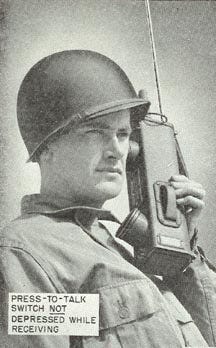 It goes without saying that the digital age has brought both pros and cons to being an Army leader. It has streamlined reporting requirements and given us access to training aids, as well as making communication instantaneous. However, it also gave us the Multi-Source Assessment, the online Officer Evaluation Report, Army Knowledge Online, and PowerPoint, so there are some definite drawbacks. With the digital age comes social media, and along with it, the site of the tops of Soldiers’ heads as they bow their heads in homage to the small device in their hands.
It goes without saying that the digital age has brought both pros and cons to being an Army leader. It has streamlined reporting requirements and given us access to training aids, as well as making communication instantaneous. However, it also gave us the Multi-Source Assessment, the online Officer Evaluation Report, Army Knowledge Online, and PowerPoint, so there are some definite drawbacks. With the digital age comes social media, and along with it, the site of the tops of Soldiers’ heads as they bow their heads in homage to the small device in their hands.
Okay, I’ll be honest, I’m one of those Soldiers. In garrison, I am an obsessive phone-checker. I am connected to both Facebook and Twitter, as well as my email accounts, all providing me a steady stream of information. I also have connected myself to the great Google Machine and have documents and presentations all available at the click of a button. I once had an NCO approach me and say, “Get off your phone, sir, Facebook can’t be that important.” To which I have responded with a robust turning of my phone towards him so that he saw I was viewing the slides for the training meeting that afternoon. But that NCO had a valuable point: it appeared that I was on social media. As a leader, appearances are everything.
That got me thinking about how I use technology and social media as a leader: is it a distraction or an enabler? Much like “the Force,” it has a dark side and a light side. The following vignettes, if you will, break down how technology can be used for good and become a leadership multiplier.
Checking the Cell Phone in Meetings
No one likes to be in meetings. Yet we have chosen a profession that relies heavily on meetings. Sit in one long enough, and you’ll start to see people stare at their crotch for long periods of time. C’mon, we all know you’re not fascinated with the mesmerizing digital camo pattern of your uniform: you’re on your phone. Meetings can be more boring than watching paint dry, but give your peers the decency of your attention. Plus, no one wants to be that guy who gets asked a pertinent question and has to say, “Um…what are we talking about?”
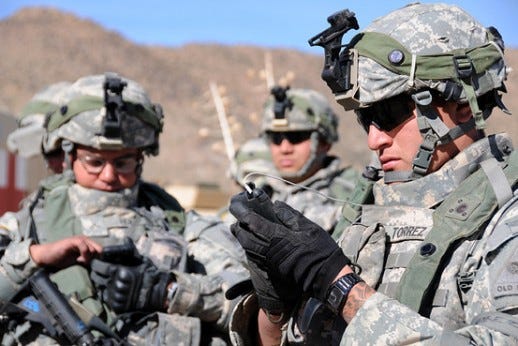 Testing for Army-approved smart phones has been underway for some time. U.S. Army photo
Testing for Army-approved smart phones has been underway for some time. U.S. Army photo
“Ooh, I got a ‘RT’ from Doctrine Man!”
The World Wide Web has done more than put field manuals and funny pictures of cats one click of a button away: it has made the entire world smaller and more intimate. That holds true for the military profession as well. Social media offers the chance to rub digital shoulders with authors, journalists, artists, and, most importantly, peers from all across the services.It enables free and open dialogue that would only ever happen before in Officer or NCO clubs, after a few drinks. This is, of course, a double edged sword, so use this ability with restraint, and maybe a few less drinks. The fact remains that using such mediums as Twitter, one can actually become a better leader: by finding new reading for professional development, engaging in thought-provoking debate, sharing ideas with peers, and getting the most up-to-date military news. And sometimes you get retweeted by Doctrine Man.
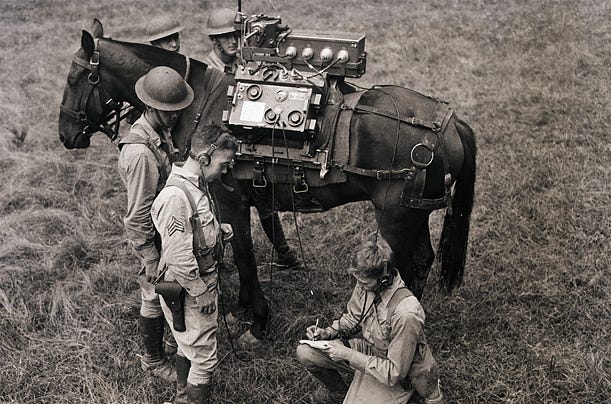 “Sir, we can’t transmit ‘lol’ as an encrypted message.” U.S. Army photo
“Sir, we can’t transmit ‘lol’ as an encrypted message.” U.S. Army photo
Sharing Documents
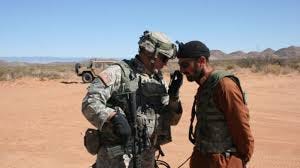 Once upon a time, we had these things called “notebooks” that we carried around with all the information we needed to survive as leaders: rosters, equipment lists, rating information, orders, meeting notes, and the doodles from those meetings. As the digital age progresses, more and more of those items are print-offs of digital formats. It is here that document sharing via some type of cloud storage (such as Google Drive) can be invaluable for leaders (provided the documents have no critical information such as social security numbers, FOUO items, etc.) One storage site can be accessed by multiple individuals making life a lot easier. Want to share some AAR comments or recommendations for awards? Throw up a note in a shared file and now all the platoon leadership can see it. When I took over my latest platoon, the last PL and I created a shared site where I could access all of the information I needed to get a good snapshot of the platoon. It does not replace a good old-fashioned sit-down with the outgoing leader, but it alleviates the pain of handing off a sheaf of documents that may or may not be useful.
Once upon a time, we had these things called “notebooks” that we carried around with all the information we needed to survive as leaders: rosters, equipment lists, rating information, orders, meeting notes, and the doodles from those meetings. As the digital age progresses, more and more of those items are print-offs of digital formats. It is here that document sharing via some type of cloud storage (such as Google Drive) can be invaluable for leaders (provided the documents have no critical information such as social security numbers, FOUO items, etc.) One storage site can be accessed by multiple individuals making life a lot easier. Want to share some AAR comments or recommendations for awards? Throw up a note in a shared file and now all the platoon leadership can see it. When I took over my latest platoon, the last PL and I created a shared site where I could access all of the information I needed to get a good snapshot of the platoon. It does not replace a good old-fashioned sit-down with the outgoing leader, but it alleviates the pain of handing off a sheaf of documents that may or may not be useful.
Texting
I never once thought that the A in my commo PACE (Primary, Alternate, Contingency, Emergency) plan in Afghanistan would ever be “cell phone.” Yet with the advance of the information age and the odd nature of the Global War on Terror as it stands now (with the majority of troops being stuck on FOBs), a cell phone with an Afghan SIM card proved to be worth every penny. I used it for day-to-day communication for everything short of secret or sensitive information. Granted, for those in actual combat missions who are not staff officers stuck in staff officer hell, it would not be helpful. But stateside, texting has become the P in my PACE plan for communicating with superiors and subordinates alike, as it offers a quick way to provide a SITREP on day-to-day activities. Knowledge is power, and the ability to transmit knowledge so quickly and efficiently should not be ignored.
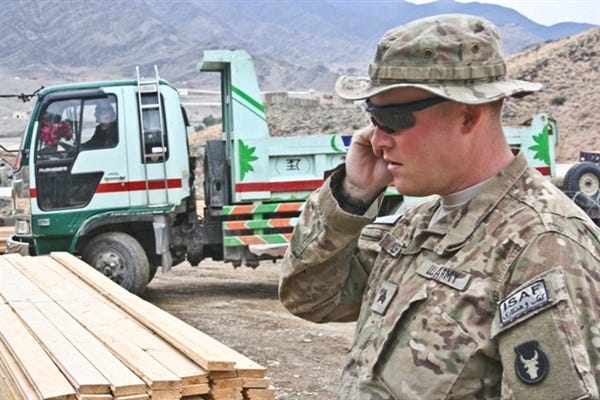 Iowa Army National Guard Sgt. Christian Kapler talks on a cell phone with his interpreter March 5, 2011, at Forward Operating Base Torkham Gate in Afghanistan’s Nangarhar province. U.S. Army photo by Staff Sgt. Ryan C. Matson
Iowa Army National Guard Sgt. Christian Kapler talks on a cell phone with his interpreter March 5, 2011, at Forward Operating Base Torkham Gate in Afghanistan’s Nangarhar province. U.S. Army photo by Staff Sgt. Ryan C. Matson
“That photo of the 1SG dancing definitely needs to be on Facebook!”
By this time, unit Facebook pages are becoming commonplace. They offer the fantastic opportunity to build a unit “brand name,” so to speak. Photos from training, promotions, or other unit events help connect families with their Soldiers’ lives. However, they must be managed carefully so as to eliminate the threat of our enemies getting their hands on Soldier data or our tactics, techniques, and procedures. Therefore, a unit page must be in the hands of a responsible and trained individual. Luckily, the Army has provided guidance for the use of such social media in units. As with everything, an ounce of common sense goes a long way. While ISIS would not gain much from a photo of the 1SG executing his finest dance moves in the patrol base at the end of the last mission, it would definitely not portray the image of a professional organization. Bottom line: think before you post.
Selfies
File this one under “NO.”
The Computer Illiterate
The digital age has come through at a rush. It has happened so swiftly that one could even classify it as a raid. For the younger generation, which I can for a few more years call myself a part, it has been an easy transition. For others, the transition has been hard. With the much-anticipated online NCOERs that are coming out, it is now the responsibility of leaders to not only be technically and tactically proficient but also computer literate. For those that are computer illiterate, the change is hard. It is a challenge for many to gain that proficiency, but in order to take care of Soldiers it is something that must be done.
In short, technology is a tool. It is up to us as leaders to discern what parts of it are useful tools and what parts are distractors. Like it or not, the digital age is here to stay, unless cyber warfare brings the whole network down, in which case, ignore everything you just read.
No comments:
Post a Comment